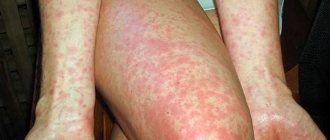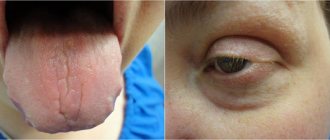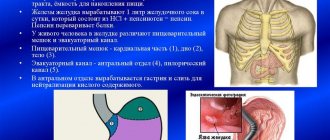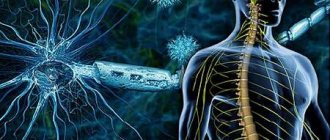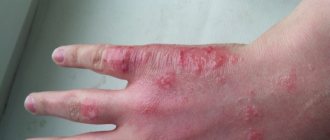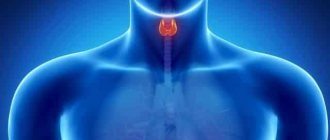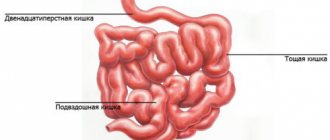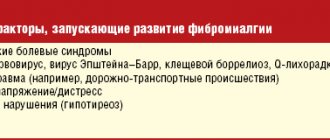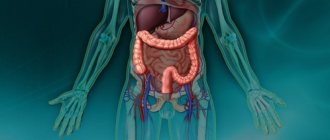Etiology and mechanisms of development of orchitis in men
Inflammation of the testicle can be caused by both infection and non-infectious factors (trauma, exposure to radiation and toxic substances).
If orchitis occurs in an acute form, it is most often a complication of infectious diseases (such as typhoid fever, typhus, mumps, scarlet fever, malaria, chlamydia, etc.). The chronic form of orchitis develops with untreated acute orchitis, or with tuberculosis, syphilis, or fungal diseases. Also, the cause of chronic orchitis can be long-term trauma to the testicle (sports - cycling, weightlifting.)
Briefly about the structure and function of the testicle
The testicles are male paired glands. They are called gonads for the reason that they produce both sperm and produce male hormones. The organs are localized in the scrotum; it is noted that the right testicle is located higher than the left. The testicle has two lateral surfaces, and the edges of the testicle are also distinguished - anterior and posterior. The epididymis is located in the posterior region. There is also a connective tissue formation called the mediastinum of the testicle. From it, septa extend into the thickness of the parenchyma.
Testicular lobules are represented by cone-shaped sections of testicular tissue containing 1-3 convoluted seminiferous tubules (sperm are formed here). The lobules are separated by partitions of connective tissue.
The fusion of the convoluted tubules continues into the seminiferous tubules, now straight. Several straight tubules located in the area of the mediastinum of the testicle depart in the form of 12 efferent tubules, which then continue into the duct of the epididymis.
Factors predisposing to the development of orchitis
There are several reasons that contribute to the occurrence of orchitis:
- hypothermia;
- immunosuppression (nervous-mental stress, viral infections, use of glucocorticoid hormones, etc.);
- the presence of chronic foci of infection not only in the urethra and bladder, but also in other organs.
Main causes (etiological agents) of testicular inflammation
According to the classification of orchitis, they are divided into:
- infectious orchitis - caused by bacteria, viruses (Trichomonas, ureaplasma, chlamydia, gonococcus, tuberculosis infection);
- non-infectious orchitis – a consequence of injuries, autoimmune processes;
- testicular torsion.
Mechanism of inflammation development
Infectious orchitis occurs due to bacteria/viruses entering the testicle with blood through the vessels (hematogenous route of infection). This mechanism is inherent in syphilis, sepsis, and viral infections.
Also, pathogenic bacteria can enter the organ through the ascending route (from the urethra and bladder). These bacteria are mainly represented by E. coli and pathogens of sexually transmitted infections (gonorrhea, chlamydia).
There is also a lymphogenous route of spread of infection - through the lymphatic vessels, as well as a mixed one - with different combinations of routes of entry.
When the testicle is injured or torsed, a damage response occurs, which is essentially inflammation.
- Acute infectious orchitis has the following features: inflammation caused by bacteria is initially represented by edema, cellular infiltration, and vascular reaction. As inflammation progresses, it, being limited to the testicular septa, moves to the tubules. Foci of suppuration and necrosis appear.
- With mumps (mumps), a week after acute mumps, unilateral inflammation of the testicle develops.
- Specific orchitis: gonorrheal: the process begins with the epididymis, ulcers form in it with the spread of purulent inflammation to the testicle;
- tuberculosis, syphilis, fungal diseases: rare pathologies, they are characterized by orchitis in a chronic form.
Causes of the disease
Several negative factors that are often found in modern life can lead to the appearance of orchitis in men.
These need to include:
- sedentary lifestyle;
- severe overwork;
- overheating or hypothermia;
- problems with regular sex life;
- chronic inflammatory processes in the body;
- presence of diabetes, hepatitis or AIDS;
- inflammation in the genitourinary system.
All this is only a small number of negative factors that can provoke the development of the disease.
Acute orchitis also occurs in newborn boys. This is due to the presence of viral diseases that have a negative effect on the reproductive system. For example, mumps or injury to the testicles can lead to the disease.
As for adults, orchitis in men appears after infectious diseases , especially if they were not treated properly. Most often, the pathology is considered a consequence of the inflammatory process in the bladder. However, it can also occur due to diagnoses such as pneumonia, sinusitis or bronchitis. Sexual intercourse can be one of the factors that can provoke testicular orchitis.
Both parts of the paired organ are most often affected only in mumps; usually on the 3rd or 10th day you can understand the degree of damage to the reproductive system. If a man suffered from the disease during puberty, then the likelihood of infertility is quite high. If the mumps has been treated properly, the threat is minimized.
In addition to mumps, the development of testicular inflammation can be influenced by diseases such as measles, influenza, and herpes. Pathology can be caused by stagnant processes, poor outflow of sperm and urine, as a result of which bacteria accumulate in the canals.
During diagnosis, a specialist often identifies a number of negative factors that could lead to inflammation of the testicles. With weak immunity and improper treatment, the disease can develop into a chronic disease.
Before you go to a specialist, you need to know what symptoms characterize inflammation in the genital organs in men. Often the reason for going to the clinic is infertility, but upon examination the doctor discovers a disease such as orchitis. With timely diagnosis and treatment, complications can be avoided.
Video: “Orchitis”
Main complaints and symptoms of testicular inflammation
If orchitis is caused by sexually transmitted infections, then in the period ranging from several weeks to several months before the first manifestations, a history indicates sexual contact.
The disease begins acutely with intense pain, enlargement of the scrotum, redness, and fever up to 38-40 degrees. The pain can radiate to the lumbar and sacral region, becoming unbearable when moving, which forces patients to limit physical activity. These symptoms disappear gradually over the course of a week, but pain on palpation and a dense consistency do not disappear for a certain period of time.
Specific orchitis occurs with suppurative complications, fistulas, distinct thickenings of the efferent duct, changes in the testicle in the form of its compaction, tuberosity.
Clinical picture
Depending on the type of disease, the patient experiences different symptoms of orchitis. Immediately after the onset of the disease, an increase in temperature occurs in the acute stage. This indicates that there are inflammatory processes in the body. Then the following symptoms appear:
Enlargement and swelling of the right or left testicle (depending on the location of the inflammation);
- Painful sensations when palpating the scrotum;
- Redness of the skin near the lesion;
- Chills, headache, nausea, weakness, dizziness and other symptoms characteristic of intoxication;
- Disturbance in proper sleep due to unbearable pain;
- Acute cutting pain from the affected testis, which can radiate to the lumbar region, back or groin; in this case, the pain becomes stronger with exercise.
If the doctor did not detect the disease in time and the patient did not begin to treat it, then orchitis will go into the stage of chronic pathology. Then the clinical picture will be different: the pain will become constant and become aching. Often, when there is inflammation of the testes in men, pain in the groin can be described as wave-like: it subsides or intensifies with hypothermia and after illnesses of viral etiology.
Among the visible signs of chronic orchitis: the appearance of suppuration of the testicles, hardening of the inflamed egg, darkening of the color or redness of the skin of the scrotum. In addition, with orchitis, men complain of symptoms such as: pain in the affected area during sex and urination, constant general weakness, increased body temperature, decreased libido.
How is the diagnosis of orchitis confirmed?
Smears from the urethra are examined microscopically (pre-stained with Gram stain). This method can diagnose the gonorrheal nature of orchitis: microorganisms are located intracellularly. If only leukocytes are detected in the smear, this indicates a non-gonorrheal cause of orchitis.
Confirmation of mumps as the cause of orchitis will be the detection of specific antibodies in the blood.
Examination methods are carried out:
- CBC (will help determine the type of pathogen - virus/bacterium, assess the inflammatory reaction);
- OAM – nonspecific signs of inflammation;
- urine culture for flora and sensitivity to antibiotics will reveal the pathogen and its vulnerability;
- spermogram analysis – will reveal pathogenic bacteria and the condition of spermatozoa;
- Ultrasound – assessment of the extent of the process, the presence of fluid;
- MRI is the most accurate method and will reveal foci of inflammation in the form of individual ulcers.
Diagnostics
The diagnosis of orchitis is made by a doctor based on examination and the presence of an infectious disease or injury in the patient.
Upon examination, the urologist can observe an enlargement of the scrotum; upon palpation, the skin of the scrotum is hot, swollen, the testicle is greatly enlarged in size, swollen and sharply painful. Of the laboratory diagnostic methods, the most conclusive confirmation of the disease orchitis is the isolation of the mumps virus from the patient’s blood, pharyngeal swabs, cerebrospinal fluid, salivary gland secretions and, of course, urine. Laboratory methods make it possible to detect viruses in a patient at the cellular level within 2 days after the first symptoms. So, to diagnose orchitis, you need to:
- General examination of urine to determine the degree of advanced inflammation;
- general blood test (when certain organs become inflamed, the number of lymphocytes and leukocytes in the blood is increased, the ESR indicator is increased);
- taking a smear to determine the causative agent of the disease;
- urine examination for the presence of bacteria or infections that cause inflammation of the testicles in men;
- examination of the patient’s sperm to study the general picture of the condition of the seminal fluid and identify the type of pathogenic microbes;
- MRI, which allows you to determine the complexity of inflammation and the degree of pathology;
- Ultrasound of the testicle to establish the general condition of the affected scrotum and identify the presence of fluid in the inflamed area.
Treatment of orchitis
Not all antibacterial drugs are able to penetrate testicular tissue and act on pathogenic microorganisms. Only groups of fluoroquinolones, cephalosporins, and macrolides have such properties.
Treatment must be comprehensive: antibacterial therapy must be combined with other auxiliary treatment methods. So, no less important is adherence to bed rest and the use of a special support bandage (suspensor).
Drug therapy
Fluoroquinolones are the most applicable: they penetrate well into the tissue of the genitourinary system. Selected representatives: norfloxacin, ciprofloxacin, ofloxacin. The duration of treatment is selected individually, taking into account the clinical severity of the inflammatory process and the blood reaction.
Non-steroidal anti-inflammatory drugs are also used: indomethacin, ibuprofen - both to eliminate inflammation and to reduce fever and relieve pain - paracetamol, analgin.
Surgical treatment of orchitis
Surgical intervention is carried out in the form of complete removal of the testicle - orchiectomy, or partial - resection.
Possible indications for surgery are:
- traumatic orchitis;
- diffuse purulent inflammation;
- lack of effect after three days of antibiotic treatment;
- dense non-absorbable infiltrates;
- orchitis with frequent exacerbations.
Physical treatments
UHF is used to eliminate inflammation, activate protective mechanisms, and improve blood circulation.
In the presence of chronic forms, reflexology, mud baths, and physical therapy are used.
ethnoscience
To date, effectiveness has not been proven. You should also take into account the speed of development of inflammation and the spread of infection: attempts to use traditional medicine methods instead of proven effective techniques can lead to disastrous consequences, including infertility.
What can be the consequences and complications of orchitis?
With a common nonspecific process, the prognosis is more favorable with adequate treatment.
With repeated relapse, blockage of the vas deferens is possible.
Orchitis most often occurs with inflammation of the appendage – epididymitis.
With a bilateral process, infertility (atrophy of testicular tissue) often occurs.
Since the testicle is an endocrine gland, when testicular tissue is damaged and sclerotic, libido decreases.
In rare cases, autoimmune processes occur - antibodies against the testicle's own cells appear in the blood (see the above-mentioned autoimmune orchitis).
Prevention of orchitis
Personal hygiene, the use of barrier methods of contraception, sanitation of foci of chronic infection, daily and nutritional regimen, vitamins are basic measures to prevent this disease.
It is also necessary to avoid hypothermia and a sedentary lifestyle. Sports activities activate blood and lymph circulation and eliminate congestion in the pelvic organs, among other things.
